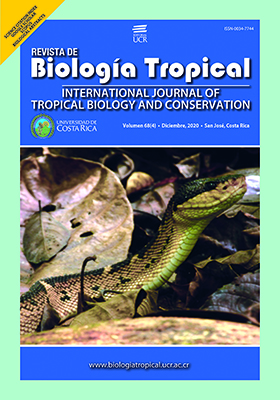Abstract
Introduction: Vanilla planifolia Andrews is a CAM plant of economic importance in the global market of flavorings and essences. Being a hemiepiphyte which initially grows in the shady understory and later climbs to the canopy, it acclimates to different conditions of radiation and humidity. The possibility of extending this crop to dry areas where the incidence of diseases is lower will depend on the response to prolonged periods of drought. Objective: To evaluate the effects of the interaction of radiation and humidity on the parameters of photosynthesis and operation of CAM of vanilla plants, and to determine if the radiation environment could help to moderate the negative effects of drought. Methods: We evaluated well-watered vanilla plants grown for 18 months in relative illumination (RI) of 8, 17, 31 and 67 %, which underwent dehydration for 94 days until reaching critical water content (relative water content, RWC < 50 %) and then rehydration for 22 days; variables evaluated were: CO2 assimilation, titratable acidity, and quantum efficiency of Photosystem II (Fv / Fm). Results: Under intermediate conditions of radiation (17 % and 31 % RI), CO2 assimilation and nocturnal accumulation of organic acids were less affected by water deficit and also showed the best recovery after rehydration. The RWC was most affected by the water available in plant tissue, while Fv / Fm was affected by radiation. The combined effects of water stress and high radiation caused irreversible damage to photosynthesis for the 67 % RI treatment. Conclusions: In vanilla plants, the negative impact of drought on photosynthetic parameters was greater in high radiation; however, in low radiation conditions the susceptibility of plants to drought also increased, as compared to intermediate radiation environments, which were under a mean photon flux density of 340 µmol m-2 s-1 (17 % IR) and 620 µmol m-2 s-1 (31 % IR). These results suggest the potential for growing vanilla in areas with seasonal drought under low-tech production systems, maintaining these radiation conditions.
##plugins.facebook.comentarios##

This work is licensed under a Creative Commons Attribution 4.0 International License.
Copyright (c) 2020 María Claudia Díez Gómez, Edison Alberto Gantiva Ramírez, Flavio Humberto Moreno Hurtado



